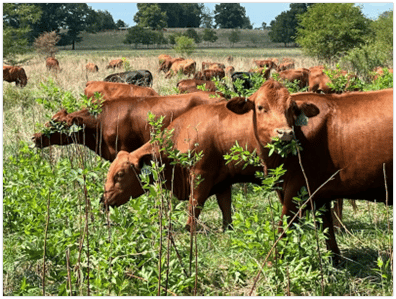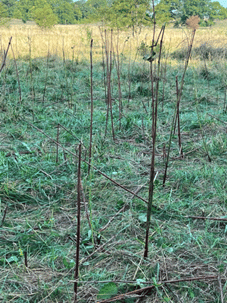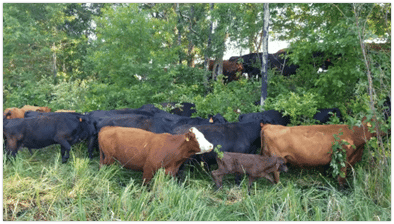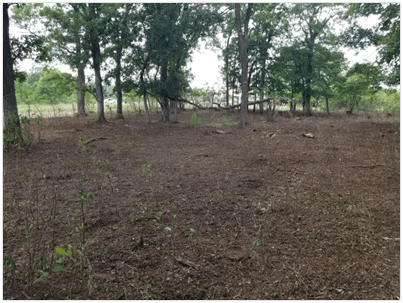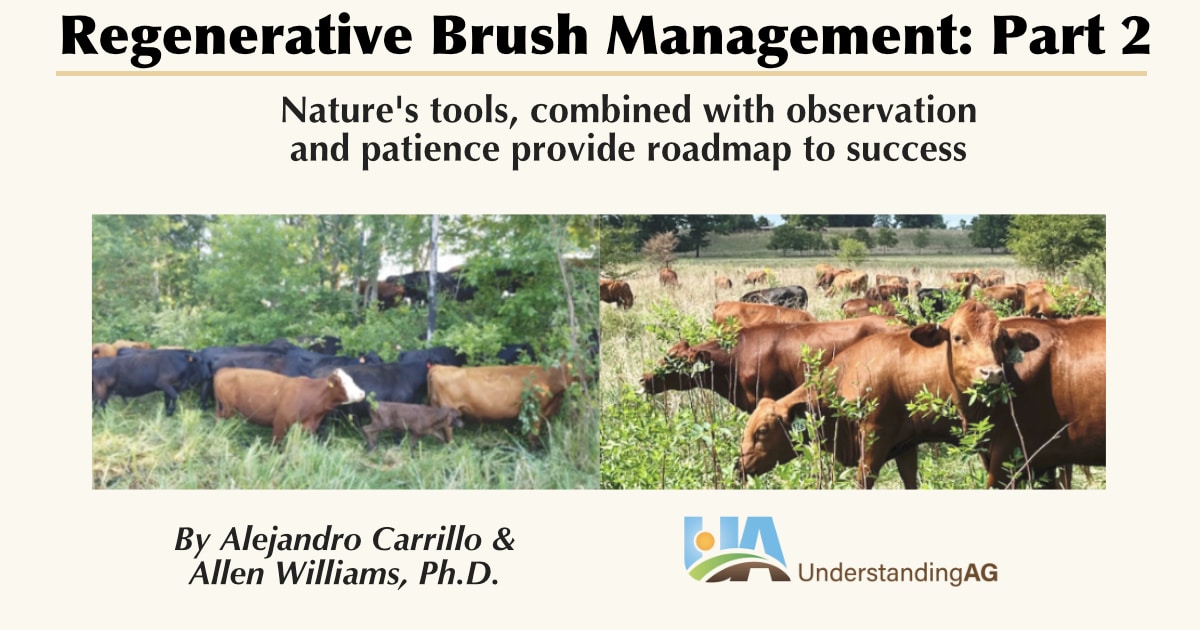
We introduced brush management tactics in part one of this series and now we will explore your best options for effective brush management and control. The first thing we must consider is why brushy and woody species dominate to begin with.
Brush encroachment almost always happens because of several factors:
• We have created patches of bare ground due to overgrazing, tillage, or other management practices that create an opportunity for brush species to gain a foothold.
• Extreme high and low temperatures in the soil. This obviously happens when we have bare spots, or poor ground cover. This past summer in the upper Midwest, we recorded soil surface temperatures routinely in the 140–160-degree range. One field we measured actually had a soil surface temperature of 162 degrees. When soil is exposed, and experiences either high or low temperatures, the first thing nature wants to do is to protect that soil. To do so, nature will recruit plant species that can quickly canopy and provide soil surface shading and insulation. That means woody species and broad leaves (what we often call “weeds”).
• Soil that is heavily compacted and plated will often try to grow woody/brushy species or weedy species in an effort to relieve the compaction and build soil aggregation and infiltration capacity. In the U.S., we have experienced far too many acres of soil that is quite heavily compacted and plated. This is obviously due to poor management practices over the centuries and even the past several decades.
• Where we see weak and oxidized grasses, we often experience woody/brushy encroachment and weedy species occurring. The grasses are so weakened that they cannot compete with the other plant species.
• Systems that are dominated by annual plant species, especially grasses. Nature prefers a perennial system and will start that system with woody/brushy species and/or weedy species.
• The dominance of shallow-rooted plants. Where we see this occurring, we will also have pressure from woody/brushy species and weedy species. This is inevitable. Shallow-rooted plants, especially grasses, are most often our fault. This is experienced in situations where pastures are routinely overgrazed by duration or overgrazed by returning too frequently (too soon). If a grazer is always striving to maintain highly vegetative grasses, then that grazer will create a shallow root system.
• Low diversity pastures. Where we have low diversity pasture systems (and they are far too prevalent) we will typically experience challenges from woody/brushy or weedy species encroachment. Low diversity systems simply are too weak to outcompete woody/brushy species.
Why did prairies and grasslands stay prairies and grasslands? Why did they not overtaken by woody/brushy species? The answer is in the seven points we just made about why brush encroachment happens to begin with. When we had large herds of wild ruminants roaming this continent, they encouraged high diversity grasslands that once were comprised of 300-plus plant species. There was a very low percentage of bare, exposed soil. The soil was highly aggregated and infiltrated water quite well. The soil was protected from extreme heat and cold by having many levels of plants growing and through a broad array of plant leaf shapes (architecture). Photosynthetic capture was very high because sunlight “leakage” was kept to a minimum.
So, what do we need to do to move from bare, exposed soil and the other problems named above to pastures that are vibrant enough to outcompete the woody/brushy species? Following are seven important steps to achieve that outcome.
1. Stabilize soil temperatures by preventing overgrazing or too frequent grazing. Allow plants to gain some measure of height and leaf volume to protect the soil from the elements. Always keep sufficient litter or ground cover on the soil after each grazing event. Always allow sufficient plant leaf material to remain after each grazing event to capture sunlight and optimize photosynthetic activity.
2. Optimize soil biological activity so the soil is sufficiently aggregated and can infiltrate rainfall.
3. Employ more adaptive grazing practices instead of prescriptive grazing practices . You will always have more woody/brushy species issues with prescriptive grazing practices.
4. Let the “soil engineers” do their work. Those engineers include soil microbes (bacteria, fungi, protozoa, bacterial-feeding nematodes), earthworms, beetles, dung beetles, and other soil-level macro-organisms. If we are using a lot of chemicals and synthetics for our pastures (i.e., herbicides, synthetic fertilizers, or even too much applied manures) or for our livestock (de-wormers, fly control, etc.) then we will significantly damage our living soil engineers and will have issues with brushy and weedy species.
5. Focus far more on growing perennial, highly diverse pastures and less on annual species. Diversity is as important here as moving from annuals to perennials.
6. Where possible, incorporate more than one species of livestock. The historical grasslands of the world (and certainly North America) had several species of wild ruminants, and other animal and bird species, impacting the landscape. Emulating that with our domesticated species allows for faster progress. As an example, we can graze cattle and sheep as complementary species. They each have a different effect on the plant species diversity, soil biology, and the ecology as a whole. Add in goats, poultry, pastured pigs and you have the ability to take care of any problem plant species.
7. Choose, or select for, genotypes and phenotypes that are ideally suited to your environment and context. Too many livestock producers are influenced by others who persuade them to select genetics that do not fit their farming/ranching context. It is hard to get animals that have been pampered to do an effective job of grazing and brush management.
Practically speaking, the three methods of brush control mentioned in part one of our series are temporary at best. Herbicides only shut down the target plants for a relatively short period of time. They do not stop seed bank recruitment, are expensive (when you add up all true costs), and adversely affect other plant species, soil biology, and total plant biomass production.
Fire is also temporary. Most brushy species that we burn will be back, and with more vigor and within just a few short years. Fire also sets back other plant species that we are depending on to out-compete the brush and can pave the way for other invasive species.
Mechanical actions often encourage the brush species to re-sprout from their base and to grow more vigorously. Mechanical methods usually create damage to the soil and can harm animal and bird species.
Adaptive grazing, with one or more livestock species, has proven to be the best method for brush and weed control. It is important to note here that if you have not been successful with brush or weed control with your livestock, you have to examine whether you are using adaptive practices or prescriptive practices. In almost every case where someone expressed not experiencing success with brush or weed control with their “adaptive” grazing, we discovered they were actually using prescriptive grazing and calling it adaptive.
There are several keys to success using livestock to control brush or weedy species.
• Do not use pampered animals to accomplish this task. They will do nothing but complain and act agitated.
• Move animals frequently and at high-stock densities. You must be able to effectively use temporary fencing and strategically placed water.
• Timing of a grazing event is important to effective control. This timing will vary according to the brush or weedy species you are attempting to control. You have to time your graze at the point where the plant in question will be most vunerable to high-stock density impact, so other favorable plant species can out-compete the targeted plant species.
• Be prepared for a second grazing event (or even a third) on the species you are attempting to control. The first event usually sets the plant back and the second event allows for greater competition from other plant species.
• Be aware of the soil moisture conditions at the time of the severe grazing event. You are wanting other plant species to out compete the undesired species, so decent soil moisture conditions are necessary.
• Use your powers of observation. There is no set time that you leave a herd or flock in a brushy paddock. You have to observe during the whole time they are in the paddock to determine when the desired impact is achieved. That is when you move them to another paddock. If you did not get the desired result, you must alter what you are doing. You often need to alter the stock density or the time they are in a paddock. Paddock configuration is also important. Livestock will have a better impact if the paddock is long and narrow, rather than a square-shaped paddock.
• Strategically place water and mineral supplements within the brushy or weedy areas to heighten impact. Do not place the water and minerals in the same spot. Spread them out at different ends of the paddock, or place them right in the middle of thick spots of brush or weeds.
• Give the impacted area plenty of time to fully recover from the more severe grazing event. Your goal is to allow other plant species to be recruited from the seed bank and to establish themselves. Going back too soon for another graze can set back the diversity you were trying to encourage. This too takes good observation.
• Limit severe grazing events in brushy areas to just a couple of days in a row or your livestock will suffer in performance. Instead, alternate between grazing in the brushy or weedy areas and grazing in better areas.
Summary
You cannot take a prescriptive or formulaic approach to brush or weed management. It takes a fully adaptive approach to be genuinely successful. Instead, be dedicated to the task at hand, adept at using temporary fencing and even temporary water, and be highly observant. Do not look for the quick fix. There is no such thing. Recognize that a second, and even a third grazing event, may be needed to gain a strong measure of control. Using livestock, especially multiple species of livestock, as your primary method of control, will reap significant dividends compared to using herbicides, mechanical control or even fire.
